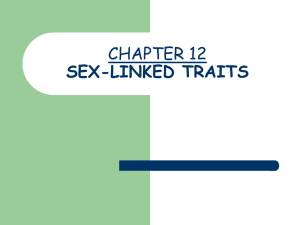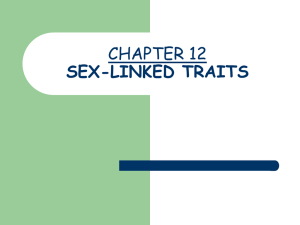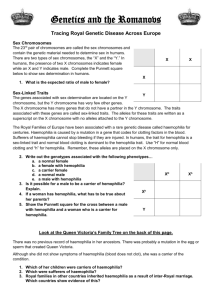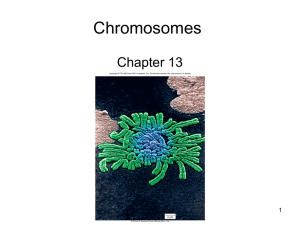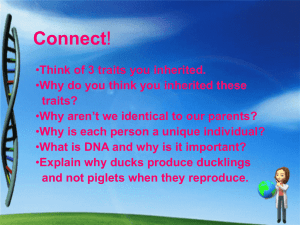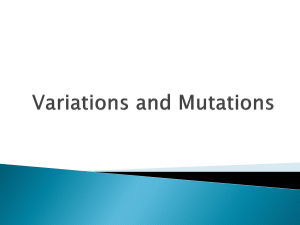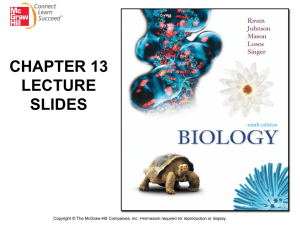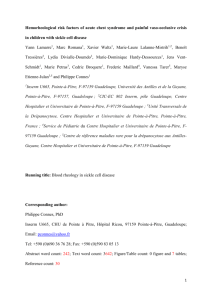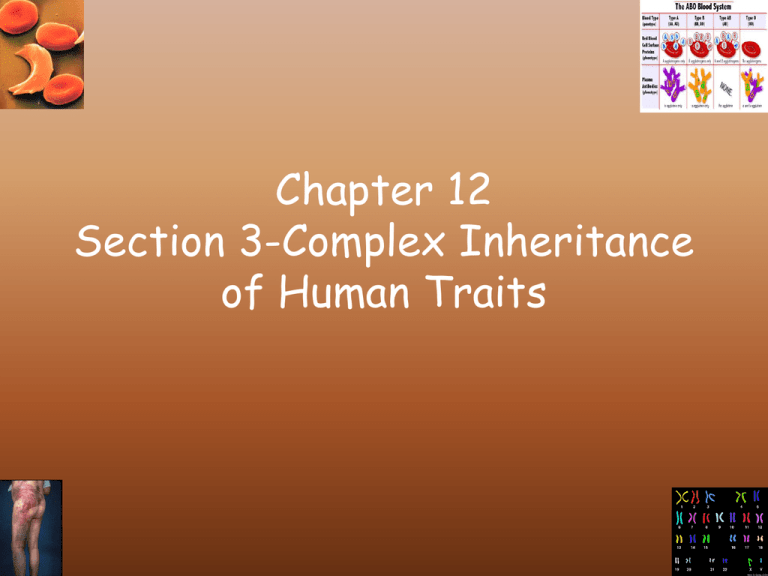
Chapter 12
Section 3-Complex Inheritance
of Human Traits
I) Codominance in Humans
• **Note: phenotypes of both
homozygotes are produced in
heterozygotes ex/sickle cell anemia
B) Sickle Cell Anemia (SCA)
i) Basics of SCA
• Major health problems in US & Africa
• Most common among in black Americans w/
origins in Africa & white Americans with origins
in the countries that surround the Med. Sea
• 1/12 African American is heterozygote for SCA
I) Codominance in Humans
i) Basics of SCA
• Hemoglobin is a protein that carries O2 in
red blood cells (RBC)
• Individuals who are homozygotes for SCA
have defective hemoglobins which form
crystal-like structures that cause shape
changes in RBC
Normal RBC
Disc Shaped
Sickle Cell RBC
Half-moon or sickle shaped
I) Codominance in Humans
ii)How sickle cell works?
1. Gene for hemoglobin produces protein that differs from
normal hemoglobin by 1 AA
2. SCA hemoglobin crystallizes when O2 levels are low after
hemoglobin delivers O2 to cells in narrow capillaries
3. Causes change in RBC from disc shaped sickle shape (see
Fig.12.16)
4. Sickle shaped RBC slow blood flow and block small vessels
– Can result in:
◊ Pain
◊ Tissue damage
◊ Short life span of RBC
I) Codominance in Humans
iv) Codominance of SCA
– Individuals who are heterozygotes for SCA means
that they produce both:
• normal hemoglobin
• SCA hemoglobin (ex/ of codominance) and they have the
SCA trait
– These individuals produce enough normal
hemoglobins to prevent serious health problems
and can live relatively normal lives
– These individuals can show signs of SCA related to
disorders if O2 availability reduced
II) Multiple Alleles govern
blood type
– ABO blood type grp classic example of
single gene with multiple alleles in humans
i) Human Blood Types
– Human blood types determined by presence
or absence of certain molecules on surface
of RBC
– Blood Type Gene: I
– (3) alleles that can be present on I gene:
• IA= surface molecule A
• IB= surface molecule B
• i = no surface molecule
GENOTYPES Type A:_____ Type B:____ Type AB:_______ Type O:___
Possibilities Type A:_____ Type B:_____
II) Multiple Alleles govern
blood type
B) Importance of Blood typing (B.T.)
– Blood typing important b/c:
• Incompatible blood type given through blood
transfusion can cause other blood types to
clump causing death
• Can be used to solve parentage:
• Ex/ Child has blood type AB, Mother has blood
type A, what must the father’s blood type be?
II) Sex-linked traits in
Humans
– Many human traits are determined by genes
carried on sex chromosomes
– Most genes carried on the X chromosome
A) How sex chromosomes are passed on?
– Males
X
Passed on to
Daughters only
Females
Y
Passed on to
Sons only
X
X
Can be passed to either
sons or daughters
II) Sex-linked traits in
Humans
• If son receives allele on X chromosomes it will be
expressed b/c males have only 1 chromosome
• 2 traits that are X-linked disorders are:
1. Red-green blindness
2. Hemophilia
B) Red-green colorblindness
– Individual can’t distinguish between red & green
– Caused by recessive allele found at 1 of (2) gene
sites on X chromosome
– Both genes affect red & green receptors in eye
cells
– Can cause problems w/ driving traffic lights
Color Blindness Tests
II) Sex-linked traits in
Humans
C) Hemophilia: An X-linked Disorder
– Clotting ability necessary human adaptation
– If clotting ability not present, could result
in:
• Excess blood loss due to minor injury
• Serious blood loss due to internal injury
• Major blood loss due to bruising
– Hemophilia A
• X-linked disorder causing a blood clotting
problem
• 1/10,000 males have hemophilia
• 1/100 million female have hemophilia
II) Sex-linked traits in
Humans
C) Hemophilia: An X-linked Trait
– Hemophilia A
• Males receive hemophilia allele from carrier
mothers on X chromosome
1. 1 recessive allele = hemophilia in males
2. 2 recessive alleles = hemophilia in females
– Treatment of hemophilia:
1. Blood transfusions
2. Injections of Factor VIII (this is a blood clotting
enzyme that is absent in hemophilic patients
III) Polygenic Inheritance
in Humans
•
Many human traits are determined by
polygenic inheritance
–
–
Ex/ variations in eye color (humans)
Ex/variations in skin color (humans)
i) Skin Color: A polygenic trait
•
•
•
1900s-skin color data used to test polygenic
inheritance theory
Light skinned individual x Dark Skinned individual
Intermediate skin color
III) Polygenic Inheritance
in Humans
– F2 generation:
•
results in range of skin colors from light skinned dark skinned like P1
generation w/ most having intermediate skin color
– Variation led to skin color being polygenic & has 3-4 genes
involved
III) Changes in
Chromosome Numbers
• Remember abnormal chromosomes #
usually happens b/c of meiosis accidents
(Process Called _________________)
• Human chromosome:
– Pairs of chromosomes = 23
– Total chromosomes = 46
A) Abnormal numbers of Autosomes
– Trisomic Humans-those individuals who
have either partial/whole extra
chromosome
– Trisomy usually caused by nondisjunction
III) Changes in
Chromosome Numbers
i) How abnormal chromosomes are ID’ed?
1.
2.
•
•
3.
Sample of cells obtained from fetus or individual
Metaphase chromosomes photographed & images are
enlarged & arranged by length & location of Centromere
Chart of chromosomes is called a karyotype
Karyotype-def-pg329-chart of metaphase
chromosome pairs arranged according to length &
location of the Centromere; used to pinpoint
unusual chromosome #s in cells
Karyotypes valuable in ID’ing unusual chromosome
#s in cells
III) Changes in
Chromosome Numbers
B) Down Syndrome: Trisomy 21
–
Most embryo w/abnormal chromosome # result in death
of the embryo
Down syndrome only autosomal trisomy that results in
embryo surviving to birth and adulthood.
Down syndrome happens in 1/700 live births
–
–
ii) Symptoms of Down Syndrome:
1.
2.
3.
4.
5.
6.
–
Some degree of mental retardation
Short stature
Weak muscles through out body
Short, wide neck with excess skin
Short/stocky arms & legs
Facial features: sm. Low set ears/nasal bridge pushed in/
irregular mouth & tongue
Incident of Down Syndrome births is er in older
mothers (especially over 40)
III) Changes in
Chromosome Numbers
C) Abnormal numbers of sex chromosomes
–
–
–
Many abnormalities in # of sex chromosomes
Any individuals w/ at least one Y chromosome is
male
Most individuals w/abnormal # of sex
chromosomes lead normal lives, but some may
result in:
1. Klinefelter syndrome (XXY)-sm testes, usually sterile
2. XYY-may be taller than normal
3. Turner’s syndrome (XO)- monosomy X-have sex organs
which don’t mature/women sterile/short/heart defects
common

